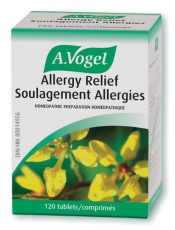In Canada, allergy season typically starts in April, when trees launch their pollen into the wind. Come June, grasses take their turn releasing pollen, followed by blossoming mid-summer moulds. And keep in mind that household moulds don’t limit themselves to a specific season. (But since I’m focusing on seasonal allergies here, I won’t get into the whole mould situation.) Last but by no means least, ragweed takes centre stage from August to October.
According to a recent CBC article, the fact that many people suffer from allergies during more than one of these four seasons has a simple explanation: they all have a trigger in common, one or more of the proteins found in plant pollen. In other words, people aren’t allergic to the plant or even its pollen, but rather to one or more of the pollen’s proteins. These same proteins are found in other plants and certain foods, such as fruits, veggies, nuts and seeds.
Once the plant’s pollen is airborne, it naturally finds its way into the lining of the respiratory tract. What differentiates an allergenic plant from a non-allergenic one is the speed at which the pollen releases its protein once embedded in the lining of the respiratory tract. A pollen that releases proteins more slowly won’t trigger an allergic reaction.
April and May
The best way to prevent an allergic reaction is, therefore, to avoid exposure to allergenic pollens. Easy, right? No, not easy at all! In April and May, trees wake up, leaves unfold and pollen drifts away into the air. And not just a little pollen, a lot of it! To reproduce, trees need to release huge quantities of the stuff and they rely on the wind to distribute their seeds. While oaks are particularly prolific pollen producers, they’re not alone in their field: equally big sources are ash, alder, Manitoba maple (acer negundo), birch, cedar, elm, maple, mulberry and walnut. They’re all very common, so common, in fact, that I can see seven of the ones I just mentioned from my window! If you’ve guessed that I don’t live downtown, you guessed right, but I’m still in the city. It’s a good thing that spring showers drag pollen to the ground, which reduces the concentration of airborne allergens.
June and July
In June and July, the grasses get to work producing pollen. Fortunately, they produce a lot less of it. Then again, grass pollen season is a long one. The most allergenic grasses are cynodon, Johnsongrass (sorghum halepense), Kentucky bluegrass (poa pratensis), timothy, fescue, orchardgrass and buffalo grass (anthoxanthum odoratum).
Mid-July to October
From mid-July on, mould spores, which also contain allergenic proteins, take flight. Moulds, which are pretty much everywhere all the time, proliferate on decomposing vegetation, grass and dead wood, as well as in the soil. In homes, moulds are particularly fond of carpets, basements and bathrooms. Not all moulds are allergenic, but the two that are cause seasonal allergy symptoms and asthma. It’s easy to confuse a grass pollen allergy and a mould allergy, because mould can be found on grasses. For example, if you feel symptoms after mowing the lawn, the trigger could be grass pollen, mould spores or both!
The queen of allergenic plants, ragweed, supplies ample quantities of allergens for the last of the hay fever seasons. This weed’s abundant pollen releases its proteins quickly. Much to our dismay, ragweed thrives in urban settings where the slightly higher temperatures also boost the plant’s pollen production.
Furthermore, the air pollution commonly found in big cities is an aggravating factor for allergies, as pollens stick to dust particles in the air and enter your already irritated and consequently more sensitive respiratory tract. Agricultural regions, where farmers frequently water their crops and cut grasses, are also perfect breeding grounds for ragweed.
Allergy Symptoms
Seasonal allergy symptoms vary from one person to the next, but on the whole, they look a lot like cold symptoms:
- Itchy, burning and runny eyes
- Itchy nose, palate and throat
- Nasal congestion or runny nose
- Sneezing
- Coughing
- Post-nasal drip
- Fatigue
How to escape the influence of allergens
To avoid every allergen out there, you’d have to barricade yourself indoors and seal up all the windows with plastic and duct tape—but even then, the mould in your home would still get you. But without going to extremes, you can still:
- Avoid drying your clothes on the clothesline so that they won’t act as a pollen filter, catching all the pollen floating around.
- Wash your hands if you’ve come in contact with an allergen. During allergy season, we’re more sensitive to other allergens, like pet dander.
- Clean your window screens, which quickly get caked up with pollen because they too act like air filters.
- Keep doors and windows closed on days when the allergen index is high. Although that is basically barricading yourself indoors, you’re allowed to on really risky days.
- In your HVAC system, use an air filter designed to catch allergens.
- Plan outings for the afternoon or evening, because pollen counts are highest in the morning.
- Wear a dust mask when gardening, but avoid mowing the lawn or raking leaves.
- Use a HEPA (high efficiency particulate arresting) air filter in the rooms where you spend the most time.
Some foods and plants can help you avoid triggering allergies:
- Stinging nettle is a plant to avoid in nature, because it can cause hives, a skin reaction that includes itching and inflammation. However, nettle extract or tea is a traditional treatment that is great for relieving allergic rhinitis—I just wouldn’t want to be the one to pick the stuff!
- Traditionally, eating local honey produced by bees that were spreading the same pollen that we’re exposed to has been used as a preventive treatment. It’s worth giving it a try a few weeks before allergy season begins.
- Something else you can start a few weeks before allergy season: A.Vogel’s Allergy Relief, a seven-plant complex that includes stinging nettle. It works by desensitizing the body to allergens while relieving the most common allergy symptoms.
- Take care of your intestinal flora by fostering lactic bacteria. An imbalance in your flora boosts your sensitivity to allergens, while increasing the risks of contracting allergies and asthma.
- Omega-3 fatty acids also provide some protection against allergies. They’re found primarily in flax seed and oil, fatty fishes and supplements.
Once you’re aware of how to dodge allergens as much as possible, and by taking a few precautions, you’ll hopefully get to enjoy the good weather and listen to birds sing rather than drowning them out with the sound of your sneezing.
References:
http://www.cbc.ca/news/health/the-four-seasons-of-hay-fever-1.1024941
https://www.mayoclinic.org/diseases-conditions/hay-fever/symptoms-causes/syc-20373039
https://www.webmd.com/allergies/news/20041223/healthy-gut-may-resist-allergies-asthma





